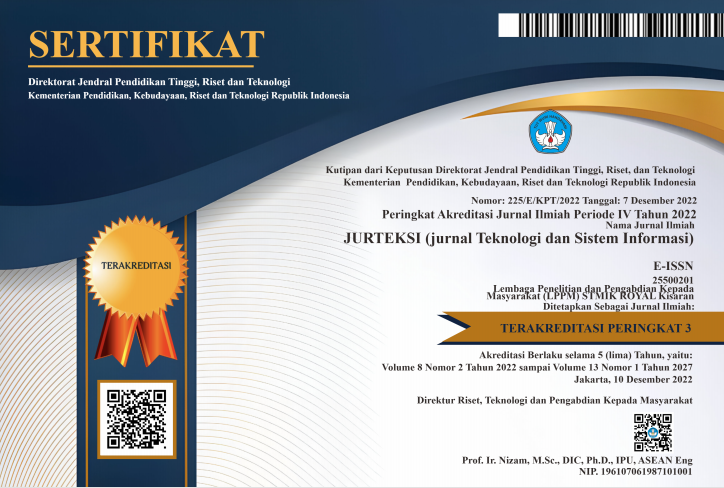DEEP LEARNING FOR CALCULATING BRAIN TUMOR VOLUME IN 3D MRI IMAGES USING HYBRID ACTIVE CONTOUR SEGMENTATION METHOD
Abstract
Abstract: Brain cancer is a serious medical condition that requires intensive and meticulous care. One of the critical steps in identifying brain cancer is the accurate measurement of tumor volume. Magnetic Resonance Imaging (MRI) is one of the most important diagnostic tools used in the medical field for brain visualization. In this discussion, we will explain how the Active Contour method can be used to calculate brain tumor volume in MRI images and how 3D visualization can assist doctors in making better diagnoses and treatment decisions. The Active Contour method, also known as the “Snake,†is an image processing technique used to identify the contours or edges of objects in images. This method works by defining an initial curve around the desired object and then iteratively shifting the curve to match the actual contour of the object in the image. In this study, the Active Contour method will be applied to brain MRI images to identify tumor edges. This research represents an important step in improving the care of brain cancer patients, enabling more accurate diagnoses and more effective treatments
Keywords: active contour; brain cancer diagnosis; 3D visualization; tumor volume
Abstrak: Kanker otak merupakan kondisi medis yang bersifat serius dimana memerlukan perawatan yang intensif dan teliti. Salah satu langkah penting dalam mengidentifikasi kanker otak adalah dengan mengukur volume tumor secara akurat. Citra Magnetic Resonance Imaging (MRI) adalah salah satu alat diagnostik yang paling penting dalam bidang medis yang digunakan untuk visualisasi otak. Dalam pembahasan ini, akan dijelaskan bagaimana metode Active Contour dapat digunakan untuk menghitung volume tumor otak pada citra MRI dan bagaimana visualisasi 3D dapat membantu dokter dalam diagnosis dan perawatan yang lebih baik. Metode Active Contour, juga dikenal sebagai “Snake,†yaitu teknik pengolahan citra yang digunakan untuk mengidentifikasi kontur atau tepi objek dalam citra. Metode ini bekerja dengan mendefinisikan suatu kurva awal di sekitar objek yang diinginkan dan kemudian menggeser kurva tersebut secara iteratif untuk menyesuaikan dengan kontur objek yang sesungguhnya dalam citra. Dalam penelitian ini, metode Active Contour akan diterapkan pada citra MRI otak untuk mengidentifikasi tepi tumor. Penelitian ini merupakan langkah penting dalam meningkatkan perawatan pasien yang terkena kanker otak dan memungkinkan diagnosis yang lebih tepat dan perawatan yang lebih efektif.
Kata kunci: active contour; diagnosis tumor otak; visualisasi 3D; volume tumor
References
N. Puspitasari, K. Nugroho, and K. Hadiono, “Usability of Brain Tumor Detection Using the DNN (Deep Neural Network) Method Based on Medical Image on DICOM,†CESS (Journal Comput. Eng. Syst. Sci., vol. 8, no. 2, p. 619, 2023, doi: 10.24114/cess.v8i2.48727.
R. Usha and K. Perumal, “A modified fractal texture image analysis based on grayscale morphology for multi-model views in MR Brain,†Indones. J. Electr. Eng. Comput. Sci., vol. 21, no. 1, pp. 154–163, 2021, doi: 10.11591/ijeecs.v21.i1.pp154-163.
A. M. Mahmoud and H. Karamti, “Classifying a type of brain disorder in children: An effective fMRI based deep attempt,†Indones. J. Electr. Eng. Comput. Sci., vol. 22, no. 1, pp. 260–269, 2021, doi: 10.11591/ijeecs.v22.i1.pp260-269.
M. Riyazudeen and M. Sathik, “Converting 2D magnetic resource imagining brain tumors to 3D structure using depth map machine learning techniques,†Indones. J. Electr. Eng. Comput. Sci., vol. 27, no. 1, pp. 513–520, 2022, doi: 10.11591/ijeecs.v27.i1.pp513-520.
A. A. Abbood, Q. M. Shallal, and M. A. Fadhel, “Automated brain tumor classification using various deep learning models: A comparative study,†Indones. J. Electr. Eng. Comput. Sci., vol. 22, no. 1, pp. 252–259, 2021, doi: 10.11591/ijeecs.v22.i1.pp252-259.
D. M. S. El-Torky, M. I. Roushdy, M. N. Al-Berry, and M. A. El-Megeed Salem, “Brain tumor visualization for magnetic resonance images using modified shape-based interpolation method,†Int. J. Electr. Comput. Eng., vol. 12, no. 3, pp. 2553–2563, 2022, doi: 10.11591/ijece.v12i3.pp2553-2563.
H. El Hamdaoui et al., “High precision brain tumor classification model based on deep transfer learning and stacking concepts,†Indones. J. Electr. Eng. Comput. Sci., vol. 24, no. 1, pp. 167–177, 2021, doi: 10.11591/ijeecs.v24.i1.pp167-177.
A. Al-Shboul, M. Gharibeh, H. Najadat, M. Ali, and M. El-Heis, “Overview of convolutional neural networks architectures for brain tumor segmentation,†Int. J. Electr. Comput. Eng., vol. 13, no. 4, pp. 4594–4604, 2023, doi: 10.11591/ijece.v13i4.pp4594-4604.
A. H. Attia and A. M. Said, “Brain seizures detection using machine learning classifiers based on electroencephalography signals: a comparative study,†Indones. J. Electr. Eng. Comput. Sci., vol. 27, no. 2, pp. 803–810, 2022, doi: 10.11591/ijeecs.v27.i2.pp803-810.
G. Weng and B. Dong, “A new active contour model driven by pre-fitting bias field estimation and clustering technique for image segmentation,†Eng. Appl. Artif. Intell., vol. 104, no. May, p. 104299, 2021, doi: 10.1016/j.engappai.2021.104299.













